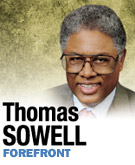Subscriber Benefit
As a subscriber you can listen to articles at work, in the car, or while you work out. Subscribe Now
 The nomination of Janet Yellen to become head of the Federal Reserve System has set off a flurry of media stories. The Federal Reserve has become such a major player in the American economy that it needs far more scrutiny and criticism than it has received, regardless of who heads it.
The nomination of Janet Yellen to become head of the Federal Reserve System has set off a flurry of media stories. The Federal Reserve has become such a major player in the American economy that it needs far more scrutiny and criticism than it has received, regardless of who heads it.
Yellen openly asks, “Will capitalist economies operate at full employment in the absence of routine intervention?” And she answers, “Certainly not.”
The former professor of economics at Berkeley represents the Keynesian economics that once dominated economic theory and policy like a national religion—until it encountered Milton Friedman and the stagflation of the 1970s.
At the height of the Keynesian influence, it was widely believed that government policy-makers could choose a judicious trade-off between the inflation rate and the rate of unemployment. This trade-off was called the Phillips Curve, in honor of an economist at the London School of Economics.
Professor Milton Friedman of the University of Chicago attacked the Phillips Curve, both theoretically and empirically. When Friedman received the Nobel Prize in economics, it seemed as if the idea of a trade-off between the inflation rate and the unemployment rate might be laid to rest.
The ultimate discrediting of this Phillips Curve theory was the rising inflation and unemployment, at the same time in the ’70s, in what came to be called stagflation—a combination of rising inflation and a stagnant economy with high unemployment.
Nevertheless, Yellen’s nomination is the crowning example of a Keynesian comeback.
Yellen asks, “Do policymakers have the knowledge and ability to improve macroeconomic outcomes rather than making matters worse?” And she answers, “Yes.”
She is certainly asking the right questions—and giving the wrong answers.
Her first question, whether free market economies can achieve full employment without government intervention, is a purely factual question that can be answered from history. For the first 150 years of the United States, there was no policy of federal intervention when the economy turned down.
No depression during all that time was as catastrophic as the Great Depression of the 1930s, when both the Fed and presidents Herbert Hoover and Franklin D. Roosevelt intervened in the economy on a massive and unprecedented scale.
Despite the myth that it was the stock market crash of 1929 that caused the double-digit unemployment of the ’30s, unemployment never reached double digits in any of the 12 months that followed the ’29 stock market crash.
Unemployment peaked at 9 percent in December 1929 and was back down to 6.3 percent by June 1930, when the first major federal intervention took place under Herbert Hoover. The unemployment decline then reversed, rising to hit double digits six months later. As Hoover and then FDR continued to intervene, double-digit unemployment persisted.
Conversely, when President Warren G. Harding faced an annual unemployment rate of 11.7 percent in 1921, he did absolutely nothing, except for cutting government spending.
Keynesian economists would say that this was the wrong thing to do. History, however, says that unemployment the following year went down to 6.7 percent—and, in the next, 2.4 percent.
Under Calvin Coolidge, the ultimate in non-interventionist government, the annual unemployment rate got down to 1.8 percent. How does the track record of Keynesian intervention compare to that?•
__________
Sowell is a senior fellow at the Hoover Institution. Send comments on this column to [email protected].
Please enable JavaScript to view this content.
